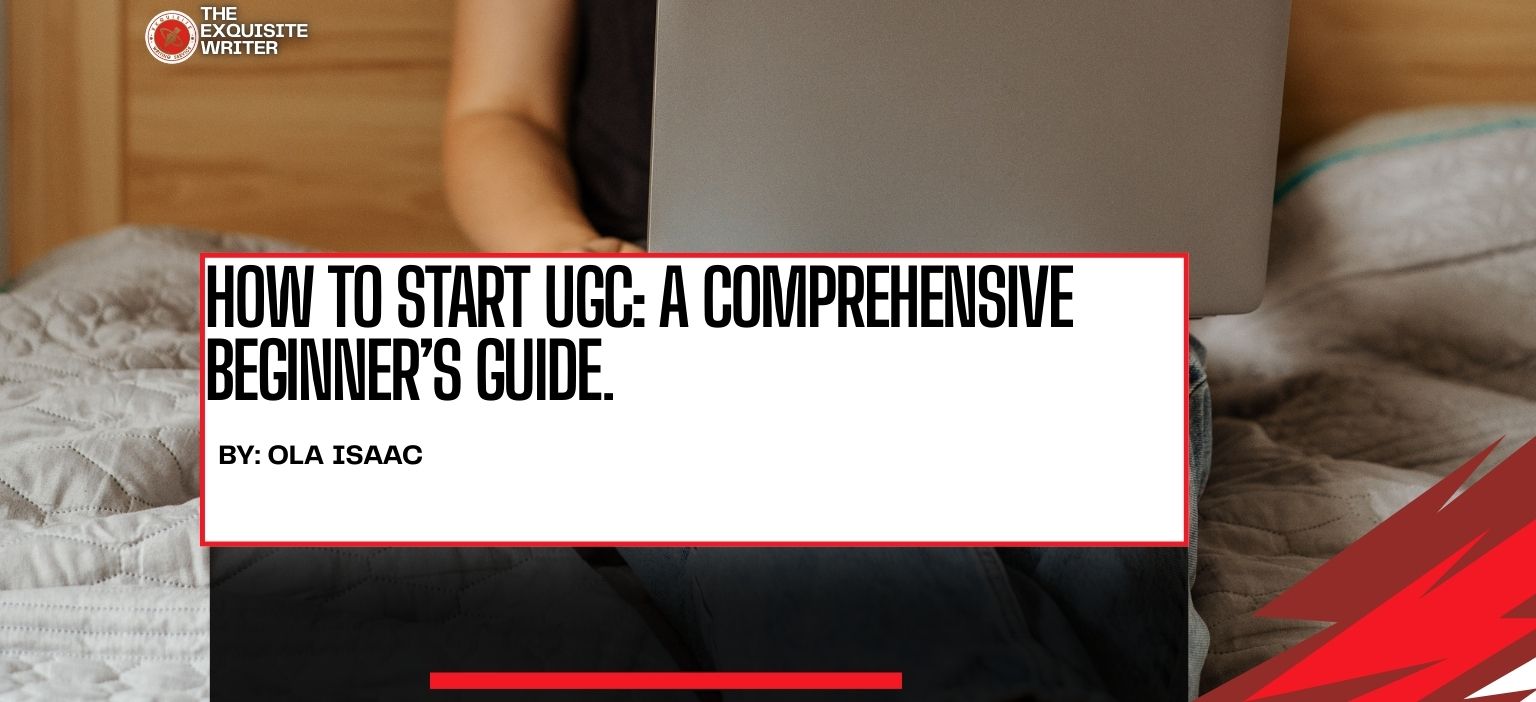Have you noticed the rise of UGC (User-Generated Content) lately, and are interested in learning how to start UGC? We warmly welcome you!
If you’ve been scrolling TikTok, Instagram, or YouTube lately, you’ve probably noticed that brands pay just everyday people—not just influencers to create authentic photos, videos, and reviews that showcase their products.
Experts see the rise of User-Generated Content (UGC) as a game-changer in digital marketing due to its ability to build trust and authenticity, boost engagement, and provide a cost-effective content source.
According to a 2023 Nielsen report, 92% of consumers trust user-generated content more than traditional advertising, making it one of the most influential content formats today.
So, whether you are looking to earn extra income, explore content creation, or even build a portfolio, we’ve created a step-by-step guide on how to start UGC in this article!

The Beginner’s Guide on How to Start UGC (User-Generated Content)
Here are the eighth steps involved in starting UGC:
1. Understand What UGC Is
UGC refers to any content—videos, photos, reviews, or social posts—created by real people rather than the brand itself.
Unlike traditional ads that often feel overly polished or staged, UGC is designed to look relatable, natural, and trustworthy.
UGC can take many forms, such as:
- Unboxing videos: Recording your genuine reaction as you excitedly open a package. These help potential buyers imagine the excitement of receiving the product.
- Product reviews and demos: This involves showing how the product works and offering an honest opinion. This builds credibility. Why? It’s simply because it’s not coming directly from the brand.
- Lifestyle shots featuring a product: This could involve sipping coffee from a branded mug during your morning routine or showing skincare as part of your daily self-care ritual.
- Tutorials or “how-to” videos: Teaching people how to use the product effectively, like assembling furniture, styling outfits, or applying makeup.
- Testimonial-style clips: Speaking directly to the camera and sharing your personal experience. It’s almost like recommending it to a dear friend.
Brands love UGC because it feels relatable, authentic, and unscripted.
Instead of hearing from a celebrity endorsement or a polished model, consumers see someone like themselves who genuinely uses the product.
That authenticity is sure to drive trust—and trust, in turn, drives conversions.
In fact, many studies show that UGC often outperforms traditional advertising because people are more likely to engage with and act on content they see or perceive as “real.”
Thus, think of UGC as the modern word-of-mouth. Instead of a friend telling you about a great product over coffee, you see it in a short-form video on Instagram, TikTok, or YouTube.
That relatability is exactly why brands invest heavily in UGC creators right now.
2. Pick Your Niche and Style
Before creating UGC, it is essential to decide what type of content you’ll focus on and how you’ll present it.
This makes your work more consistent and helps brands quickly recognize if you’re the right match for their audience.
Thus, here are the key essential things to consider:
- Your interests: Kickstart with areas you’re naturally passionate about. If you are a fan of skincare, product demos, and beauty tutorials, you’ll find it fun and easy.
You might be a better fit if you’re into fitness, health supplements, or workout gear. Tech enthusiasts can create gadget reviews, while food lovers might thrive making recipe videos or restaurant content.
- Your strengths: Everyone has a different content style. Maybe you’re confident speaking on camera. Thus, testimonial-style videos will come naturally to you. Or perhaps you’re great at editing and can turn simple clips into dynamic, scroll-stopping ads. If you enjoy storytelling, you can build narratives around products—such as showing a “before and after” transformation.
- The audience you connect with: Think about who resonates with you. Do you relate more to young professionals, college students, parents, or gamers? Brands are seeking creators who can authentically connect with their target demographic. If your natural vibe already aligns with a specific group, lean into that.
Having a niche doesn’t translate to boxing yourself into one type of content forever—it just gives you a clear starting point. For example:
- A beauty UGC creator might focus on skincare routines, makeup hauls, or “get ready with me” videos.
- A tech UGC creator could review gadgets, explain app features, or compare products.
- A travel UGC creator might showcase luggage, hotel experiences, or destination guides.
By selecting a niche and style, you will make it easier for brands to see how your content aligns with their vision.
Instead of looking like a “generalist,” you’ll stand out as someone who truly understands a specific space and can create relatable content for that audience.
3. Set Up Your Tools
One of the biggest myths about UGC is that you need a full studio setup to create professional-looking content.
What actually is the truth?
You can start with what you already have!
Most brands prioritize authenticity and creativity over cinematic quality.
Here’s what you’ll need to get started:
- A smartphone with a good camera: Today’s smartphones (Samsung, iPhone, or Google Pixel) can shoot in high resolution, making them perfect for UGC.
Clean your lens before taking any pictures or filming to avoid blurry footage. You don’t need the latest model—just ensure your video quality is clear and sharp.
- Lighting: Good lighting is key. In fact, it is more important than expensive equipment. Natural daylight is your best friend.
Therefore, try filming near a window during the day. If you don’t have consistent natural light, a softbox or ring light is an affordable option that instantly makes your content appear more polished and professional.
- Basic editing apps: Simple edits can elevate your content.
Free and user-friendly apps like InShot, CapCut, VN, Canva, or Premiere Rush allow you to trim clips, add captions, adjust lighting, and include sound or music effects.
Start with these tools before exploring more advanced tools like Final Cut or Adobe Premiere Pro.
- A clean, minimalist background: Brands want the product to stand out. Thus, avoid cluttered or distracting spaces.
A plain wall, a tidy desk, or a simple lifestyle setting (like your kitchen counter for food content) works well.
As you get more comfortable and start to work with brands, you might want to upgrade your setup gradually:
- Tripod: This tripod keeps your shots steady, freeing your hands. It is excellent for tutorials, unboxings, and “talk-to-camera” clips.
- Microphone: Enhances sound quality, especially when recording voice-overs or testimonial videos.
Affordable lapel mics that plug into your phone can make a big difference.
- Advanced editing tools: Once you’re ready, tools like Final Cut Pro, Adobe Premiere Pro, or DaVinci Resolve allow you to take your content to a more professional level.
The key is to start simple, get better as you go, and upgrade when it makes sense.
Remember: Many viral UGC clips were shot on a phone with natural light and minimal editing.
Related: 25 Best Free Offline Writing Apps to Enhance Your Productivity
4. Build a Portfolio
UGC creators, such as designers, photographers, and writers, require a portfolio to showcase their skills.
Brands don’t just want to hear that you can create engaging content; they are willing to see it.
The good news is, you don’t need to wait for your first paid project to build one.
Here’s how to get started:
- Use products you already own: Take a look around your home. Do you have makeup, skincare, fitness gear, tech gadgets, or kitchen tools you love?
Use them to create sample videos.
Brands won’t mind that you bought the product yourself—they care about how you showcase it.
- Record a variety of content styles: Mix things up to demonstrate versatility. For example:
- An unboxing video showing your excitement as you open the package.
- A “day-in-the-life” clip casually featuring the product in your routine.
- A testimonial where you speak directly to the camera, explaining the reasons you like the product.
- A tutorial/demo walking viewers through how the product works.
- Keep it short and engaging: Most UGC content works best between 15–45 seconds, which aligns with Reels, TikTok, and YouTube Shorts.
The key is instantly grabbing attention with a strong opening line or visual hook.
- Package your portfolio professionally: Don’t just keep videos on your phone. Upload them somewhere easy to share, like:
- Google Drive or Dropbox (organized folders with thumbnails)
- Canva presentation (branded, visual layout of your best work)
- A dedicated Instagram/TikTok account showcasing only your UGC samples
By building even a small starter portfolio of 5–10 videos, you’ll have something tangible to send to agencies and brands.
5. Create a UGC-Friendly Social Presence
While follower count isn’t the main factor in UGC, having a professional online presence signals credibility and makes it easier for brands to find and trust you.
Think of it as your digital business card.
Here’s how to set it up:
- Post your portfolio content on TikTok or Instagram: Consistency matters more than perfection. So, treat your page as a “UGC sample gallery” instead of a personal diary.
- Use UGC-focused hashtags: These help recruiters, brands, and agencies to discover you. Examples:
- #UGCContent
- #UGCCreator
- #UGCCommunity
- #UGCAds
- #ContentCreator
- Optimize your bio: Keep your bio clear and direct. For example:
- “UGC Creator | Lifestyle & Beauty | Content for brands”
- “Helping brands create authentic short-form ads!”
- Show professionalism: Be sure to add a contact email in your bio and consider creating a separate UGC-only account.
That way, brands can see you as dedicated to this space.
- Engage with the UGC community: Comment on other creators’ posts, join UGC Facebook groups, and interact with brand accounts.
Being active will no doubt increase your visibility.
Even if you don’t have thousands of followers, a polished profile with high-quality sample content tells brands: “This creator is serious, reliable, and ready to collaborate.”
6. Start Pitching to Brands
Waiting for brands to find you can be slow, especially when you’re just starting out.
Instead, take initiative and reach out directly.
Pitching depicts confidence, professionalism, and drive—all qualities brands appreciate.
Here’s how to do it effectively:
- Identify companies you genuinely like: Think of brands you already use and enjoy.
It’s easier to create authentic content when you believe in the product.
Start with small to mid-sized businesses—they’re often more open to working with new creators.
- Find the right contact: Look for social media managers, influencer marketing specialists, or brand partnerships leads. You can:
- Search LinkedIn job titles at that company.
- Check the brand’s website for a PR or marketing email.
- Send a polite DM on Instagram or TikTok asking who handles UGC collaborations.
- Craft a short, professional pitch: Keep it focused and simple.
Mention who you are, what you do, and how you can help. Example:
- Hi [Name], I’m a UGC creator specializing in product demo videos and lifestyle. I love [Brand/Product] and would love to create authentic short-form content to showcase how it fits into everyday life. Here’s a link to my portfolio: [insert link]. Would you be open to discussing a collaboration?
- Leverage UGC platforms and marketplaces: Many brands use platforms to connect with creators.
Some popular options include:
- Aspire – Connects creators with leading brands running UGC campaigns.
- Insense – Helps match UGC creators with e-commerce brands.
- Trend.io – Offers paid campaigns for product-based content.
- Fiverr/Upwork – You can list UGC creation as a service and attract inbound leads.
The key is persistence. Not every brand will respond, but each pitch is enough to help you refine your approach.
7. Learn How to Price Your Work
Pricing can truly feel tricky when you’re new, but it’s vital to value your skills and time.
Rates depend on experience, content type, usage rights, and the brand’s size/budget.
- Beginner rates: Many new creators start at $50–$150 per video or $100–$250 for a package of 2–3 videos.
This is a solid entry point to build your portfolio while getting paid.
- Intermediate rates: As you gain experience and results, you can charge $200–$500 per video. Brands are often willing to pay more for creators with proven editing and storytelling skills.
- Advanced/pro rates: Experienced creators working with bigger brands may earn $750–$2,000+ per video, primarily if the content will be used in paid ads across multiple platforms.
In addition to your base rate, consider charging for:
- Usage rights: If a brand desires to run your content as paid ads, you can charge a monthly fee or a flat rate for licensing.
Example: An additional 20–50% of your base rate per month of ad usage.
- Exclusivity: If a brand requests that you not work with competitors in the same niche, you should be compensated for the missed opportunities.
Exclusivity fees vary, ranging from a few hundred dollars to several thousand, depending on the industry and timeframe.
Pro tip: Always put agreements in writing.
Even a simple contract or email confirmation outlining deliverables, deadlines, rates, and rights can protect you and ensure professionalism.
8. Keep Improving
UGC is one of the fastest-growing areas of digital marketing—and that means more and more creators are entering the space every day.
To stand out and stay relevant, you must continually sharpen your skills and evolve with the trends.
Think of it like working out: the more consistent effort you put in, the stronger and more polished your content becomes.
Here’s how to keep leveling up as a UGC creator:
- Study viral ads and UGC examples: Spend time on Instagram, TikTok, Instagram Reels, and YouTube Shorts to watch high-performing ads. Pay attention to:
- The hooks (first 3 seconds) that grab attention.
- The tone—funny, casual, emotional, or educational.
- The editing style—quick cuts, text overlays, or trending sounds.
- The call-to-action (CTA) at the end drives users to take action.
By reverse-engineering what works, you’ll understand what brands are looking for and how to replicate success in your style.
- Experiment with different formats: Don’t stick to one type of content. Experiment with voiceovers, trending sounds, direct-to-camera testimonials, or story-driven skits.
Experimenting allows you to discover what resonates most with audiences and keeps your portfolio diverse.
- Improve your editing skills: Editing can make or break UGC. Learn how to eliminate unnecessary pauses, add captions (many viewers watch without sound), and synchronize pacing with music or voiceovers.
Even small improvements in editing can make your content appear more professional.
- Stay consistent: UGC isn’t about one “perfect” video. The more you create, the more you learn.
Therefore, set a goal to produce and upload new content regularly, whether that’s one video a week or a few samples each month.
Consistency builds both your skills and your visibility.
- Update your portfolio regularly: As you create new content, replace older samples with more recent and stronger ones.
Brands want to see your latest quality and style, so keeping your portfolio fresh signals growth and relevance.
- Learn from feedback: If a brand provides notes or revisions, take them as opportunities for learning.
Each collaboration teaches you more about what works in various industries and with different audiences.
- Invest in yourself: With time, consider:
- Taking short online courses on marketing, copywriting, or video editing.
- Joining UGC communities on TikTok, Discord, or Facebook to exchange tips.
- Upgrading your gear gradually to improve quality without losing authenticity.
UGC is a space where practice plus adaptability = long-term success!
The creators who continually improve, test, and remain flexible will not only attract more brand deals but also build a sustainable career in content creation.
Frequently Asked Questions About Starting UGC
1. Do I need followers to be a UGC creator?
No. Brands care about content quality, not follower count.
2. How much can beginner UGC creators earn?
Anywhere from $50–$150 per video to start, depending on usage rights.
3. Do brands send free products?
Yes. Many campaigns include gifted products plus payment for the content.
4. How do I get my first UGC client?
Start by pitching small brands, using a simple portfolio with 5–10 samples.
Next: 7 Proven Generative Engine Optimization Strategies
Final Thoughts
Now, you’ve learned how to start UGC. How would you sum up the lessons?
Starting UGC is less about perfection and more about authenticity.
With consistency, creativity, and a clear niche, anyone can break into the UGC space and start earning.
Begin with what you have, refine as you grow, and let your unique voice guide your content journey.
Starting ugc doesn’t require a massive following, expensive gear, or years of experience.
What matters most is creativity, authenticity, and consistency.
If you enjoy creating content and sharing stories about products you love, it’s possible to turn that passion into a profitable side hustle—or even a full-time career.
If you’re ready to create high-quality UGC or want to improve your brand’s authenticity, reach out to us at The Exquisite Writer. Let’s craft content that feels real, relatable, and results-driven.
About the Author
This guide was created by The Exquisite Writer, a content creation and digital storytelling agency specializing in SEO-driven content, UGC, and brand messaging for creators and businesses.


3 thoughts on “How to Start UGC: A Comprehensive Beginner’s Guide”